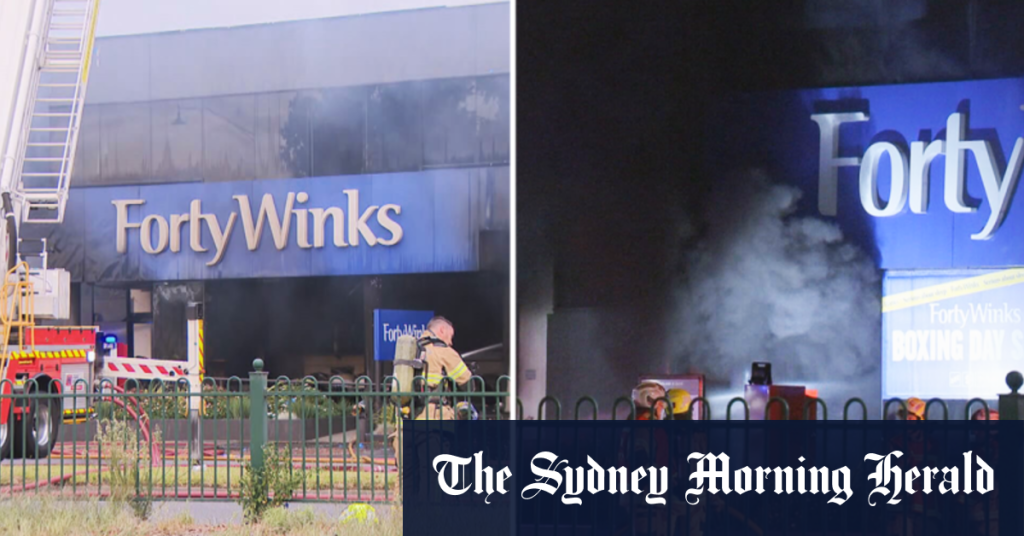The pre-dawn hours of January 5th, 2025, witnessed a devastating fire engulf a shopping complex in Melbourne’s east, reducing the structure to rubble and leaving a trail of destruction in its wake. The inferno, which erupted before 7:39 am, quickly consumed the building, sending plumes of thick, black smoke billowing into the sky, visible for miles around. Firefighters battled tirelessly against the raging flames, hampered by the intensity of the fire and the complex layout of the shopping center. The scale of the disaster prompted a massive emergency response, with multiple fire crews, police, and paramedics converging on the scene. Initial reports suggested no casualties, though a full assessment was pending once the fire was fully extinguished and the debris cooled sufficiently to allow for safe entry. The incident brought shock and disbelief to the local community, leaving many businesses and livelihoods in ruins.
As dawn broke, the full extent of the devastation became tragically clear. The once-vibrant shopping complex was reduced to a skeletal frame, twisted metal, and charred debris. The air remained thick with the acrid smell of smoke, a stark reminder of the inferno that had raged just hours earlier. Fire investigators began their painstaking work, sifting through the wreckage to determine the cause of the blaze. Early speculation pointed towards an electrical fault, though a thorough investigation was crucial to ascertain the precise origin and prevent similar tragedies in the future. The impact on the local economy was expected to be significant, with numerous businesses forced to close indefinitely, leaving employees and business owners facing an uncertain future.
The fire’s impact rippled through the community, affecting not only business owners and their employees but also the residents who relied on the shopping complex for their daily needs. The loss of local shops, supermarkets, and services created a void in the community, leaving residents scrambling to find alternative sources for groceries, pharmaceuticals, and other essential goods. The incident underscored the vital role of local businesses in the fabric of a community and the devastating consequences when such hubs are unexpectedly lost. Community support rallied around those affected, with offers of assistance, donations, and temporary accommodations pouring in, demonstrating the resilience and compassion of the human spirit in the face of adversity.
Beyond the immediate economic and social repercussions, the fire also raised concerns about fire safety regulations and building codes in commercial structures. Questions arose regarding the adequacy of existing fire prevention measures and the effectiveness of emergency response protocols. The incident prompted calls for a comprehensive review of building standards and fire safety regulations to ensure that such tragedies are prevented, or at least mitigated, in the future. This review encompassed aspects such as sprinkler systems, fire alarms, evacuation routes, and fire-resistant materials used in construction, aiming to strengthen safety measures and protect lives and livelihoods.
As the days turned into weeks, the arduous task of rebuilding began. Insurance assessments were conducted, debris cleared, and plans drafted for the reconstruction of the shopping complex. While the physical structures could be rebuilt, the emotional scars and economic hardships lingered. The incident served as a stark reminder of the vulnerability of businesses and communities to unforeseen disasters and the importance of preparedness, resilience, and community support in navigating such challenges. The rebuilding process was not just about bricks and mortar but also about restoring the heart of the community and providing hope for a brighter future.
The fire that ravaged the Melbourne shopping complex served as a tragic but potent reminder of the importance of fire safety, community resilience, and the interconnectedness of local economies. While the immediate aftermath was marked by devastation and loss, the community’s response showcased the strength of human spirit and the ability to overcome adversity. The rebuilding process would undoubtedly be lengthy and challenging, but the collective determination to restore the heart of the community offered a glimmer of hope amidst the ashes. The incident also sparked crucial conversations about preventative measures and building regulations, paving the way for enhanced safety standards and a renewed focus on community preparedness for future emergencies.

